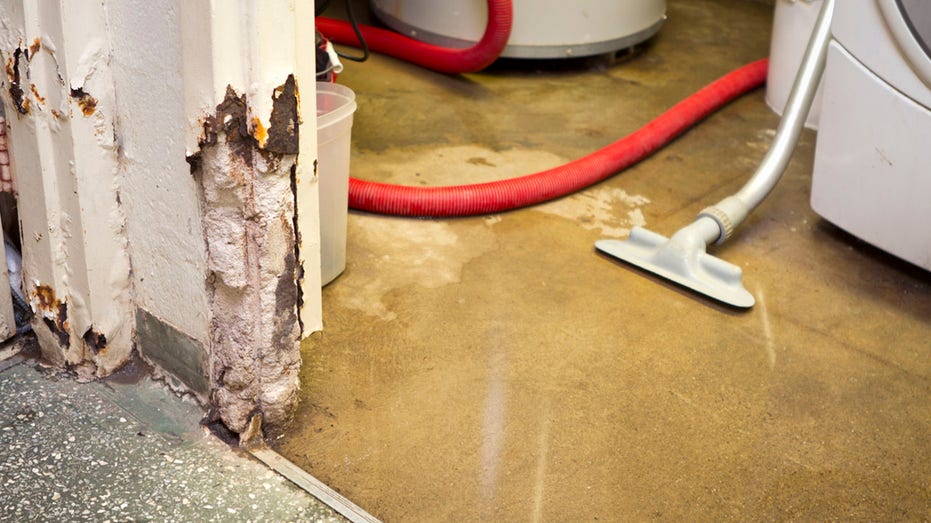How to clean up a flooded basement, treat mold, according to experts
Tips for cleaning flooded homes from the EPA, FEMA and the American Red Cross
Hurricane Ida's impact on housing 'not a Katrina event': Real estate exec
Corporate Realty president Michael Siegel gives a positive outlook on market rebound post-storm.
After Hurricane Ida and its remnants hit the East Coast this week, many homeowners have been left with flood damage.
Though it’s important to clean out a flooded basement quickly to avoid mold growth, there are other important steps to take first, according to experts.
According to Allstate, the first thing homeowners should do after a flood is to check for gas leaks and loose power lines – without touching them. If there are any, contact your utility company.
8 COUNTIES IN THESE 3 STATES ACCOUNTED FOR HALF OF FLOOD CLAIMS IN 2020: REPORT
Homeowners should also check the foundation for cracks or obvious damage. If it seems unsafe, or if there’s water standing next to the outside of the house walls, Allstate says people should not enter their homes.
Before entering your home, make sure to turn off the gas and electricity, Allstate says.

In the wake of Hurricane Ida and its remnants, here are some tips for cleaning up your flooded home. (iStock)
According to the EPA, homeowners should make sure to take pictures of their homes and belongings for insurance purposes.
HURRICANE TIPS FOR FLOODING, HIGH WATER
Here’s what else you need to know about cleaning up your flooded home.
Wear protective gear
To clean up any flood damage, the EPA recommends wearing an N-95 mask to avoid breathing in mold, rubber gloves and goggles to keep out dust and small particles. The American Red Cross also recommends wearing long sleeves and long pants and boots or work shoes.
Don’t pump water out too quickly
If there is still water in your basement, FEMA says homeowners should not pump it all out immediately, because the floor could crack and the walls could collapse with the quick change in pressure.
Instead, FEMA recommends that homeowners follow its "recommended rate to pump" by drawing down one foot of water, waiting 24 hours, drawing down another foot of water and waiting another 24 hours.
IDA REMNANTS CAUSE AMTRAK TO CANCEL SERVICE BETWEEN WASHINGTON AND BOSTON
If the water level remains down after those steps, you can draw down 2-3 feet of water every 24 hours, according to FEMA.
Once your basement is empty of water, FEMA says homeowners should "act fast" on clean up.
"Time is critical to combat the threat of mold, which can appear in one or two days," FEMA says.
Louisiana business owners on Hurricane Ida's impact
Mopho & Maypop chef and partner Michael Gulotta, Cure, Vals and Cane and Table owner Neil Bodenheimer, and Marks Group President Gene Marks on the impact Hurricane Ida has had on small businesses.
Clean out items, debris
According to Allstate, homeowners should first find their "irreplaceable" items and put them in an elevated and dry place.
According to Allstate, homeowners should also remove all debris and mud – which "may contain many health hazards" – from their home and make some repairs like patching any holes in the roof, walls or windows, check for broken pipes, and brace sagging floors and ceilings.
GET FOX BUSINESS ON THE GO BY CLICKING HERE
The American Red Cross says homeowners should throw out any food, beverages or medication that has come into contact with flood waters, as well as any items that absorb water that can’t be cleaned or disinfected such as mattresses, carpeting, cosmetics, stuffed animals and baby toys.
According to FEMA, "all wet materials, mud and debris must be removed to the outside of the house."
Dry out your home
The EPA recommends opening all doors, windows, cabinets and drawers to give your home some airflow to help it dry out.
"When electricity is safe to use, use fans and dehumidifiers to remove moisture," the EPA says.
CLICK HERE TO READ MORE ON FOX BUSINESS
Harrison Township, NJ mayor says Ida had ‘devastating’ impact
Harrison Township Mayor Louis Manzo details the damage following Hurricane Ida.
According to FEMA, homeowners should cut away wet wallboard and insulation "at minimum one foot above the high water line." They should then "scrub every surface touched by contaminated water" and make sure there aren’t hidden pockets of water.
"Vacuum any remaining water and run fans and dehumidifiers," FEMA says.
The EPA recommends drying your home and everything in it "as quickly as you can," within 24 or 48 hours, of possible.
Clean all mold
To clean mold, FEMA recommends mixing 1.5 cups of bleach per gallon of sudsy water and spraying the mixture on any mold before using a stiff brush on the mold.
"Let the affected area air dry," FEMA says. "If it takes a week for visible moisture to dry, it will take at least another week for unseen parts to dry."
HURRICANE IDA: FOOD STORES STRUGGLE TO REMAIN STOCKED AMID SHORTAGE
"Treat again as necessary," the agency says on its website.
According to the EPA, mold cleanup must be complete before you can move back into your home, to avoid health issues such as asthma attacks, eye and skin irritation and allergic reactions.
For more information on cleaning out flooded homes, check out these resources from FEMA, the EPA and the American Red Cross.























